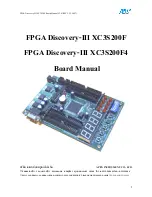
15
1.
16-Bit Digital Line Scan Cameras
These PALs (
2by16bitLS
) implement a 16-bit line-scan camera input for the FastImage
board. Two TriMedias are fed from each 16-bit line-scan camera. Each TriMedia can
start or stop capture at the end of a line using the I2C bus.
PAL1 does all of the data capture for processors 0 and 1. PAL2 provides for a second
camera input which connects to processors 2 and 3.
Processors must use raw 8-bit capture mode and set the buffer size to an integral number
of lines. Note that in continuous capture mode it is possible to set the buffer as small as 1
line, however this places a high interrupt overhead on the TriMedia processor as it needs
to set up for the next buffer as each buffer is filled.
Taps 1 and 2 provide data inputs for the odd and even bytes of the first camera
respectively. Strobe (pixel clock) and Line Valid signals must be presented on Tap 1.
Taps 3 and 4 provide data inputs for the odd and even bytes of the second camera
respectively. Strobe (pixel clock) and Line Valid signals must be presented on Tap 3.
Data and control are sampled on the rising edge of the pixel clock. The cabling below
represents a swap in the STROBE differential pair to effectively invert the clock to the
frame grabber.
Minimum connections for each camera:
Camera:
Signal:
Alacron 10024-00161 cable
(Mates with 2 x DB37 male)
OS1-1
D7
P2-6
OS1-2
D7B
P2-25
OS1-3
D6
P2-7
OS1-4
D6B
P2-26
OS1-5
D5
P2-8
OS1-6
D5B
P2-27
OS1-7
D4
P2-9
OS1-8
D4B
P2-28
OS1-9
D3
P2-10
OS1-10
D3B
P2-29
OS1-11
D2
P2-11
OS1-12
D2B
P2-30
OS1-13
D1
P2-12
OS1-14
D1B
P2-31
OS1-15
D0
P2-13
OS1-16
D0B
P2-32
OS1-17
STROBE P2-34
OS1-18
STROBEB
P2-15
OS1-19
LVAL
P2-17
OS1-20
LVALB
P2-36
OS2-1
D7
P3-6
OS2-2
D7B
P3-25
OS2-3
D6
P3-7
OS2-4
D6B
P3-26
OS2-5
D5
P3-8
OS2-6
D5B
P3-27
OS2-7
D4
P3-9
OS2-8
D4B
P3-28
OS2-9
D3
P3-10
OS2-10
D3B
P3-29
OS2-11
D2
P3-11
OS2-12
D2B
P3-30
OS2-13
D1
P3-12
OS2-14
D1B
P3-31
OS2-15
D0
P3-13
OS2-16
D0B
P3-32









































